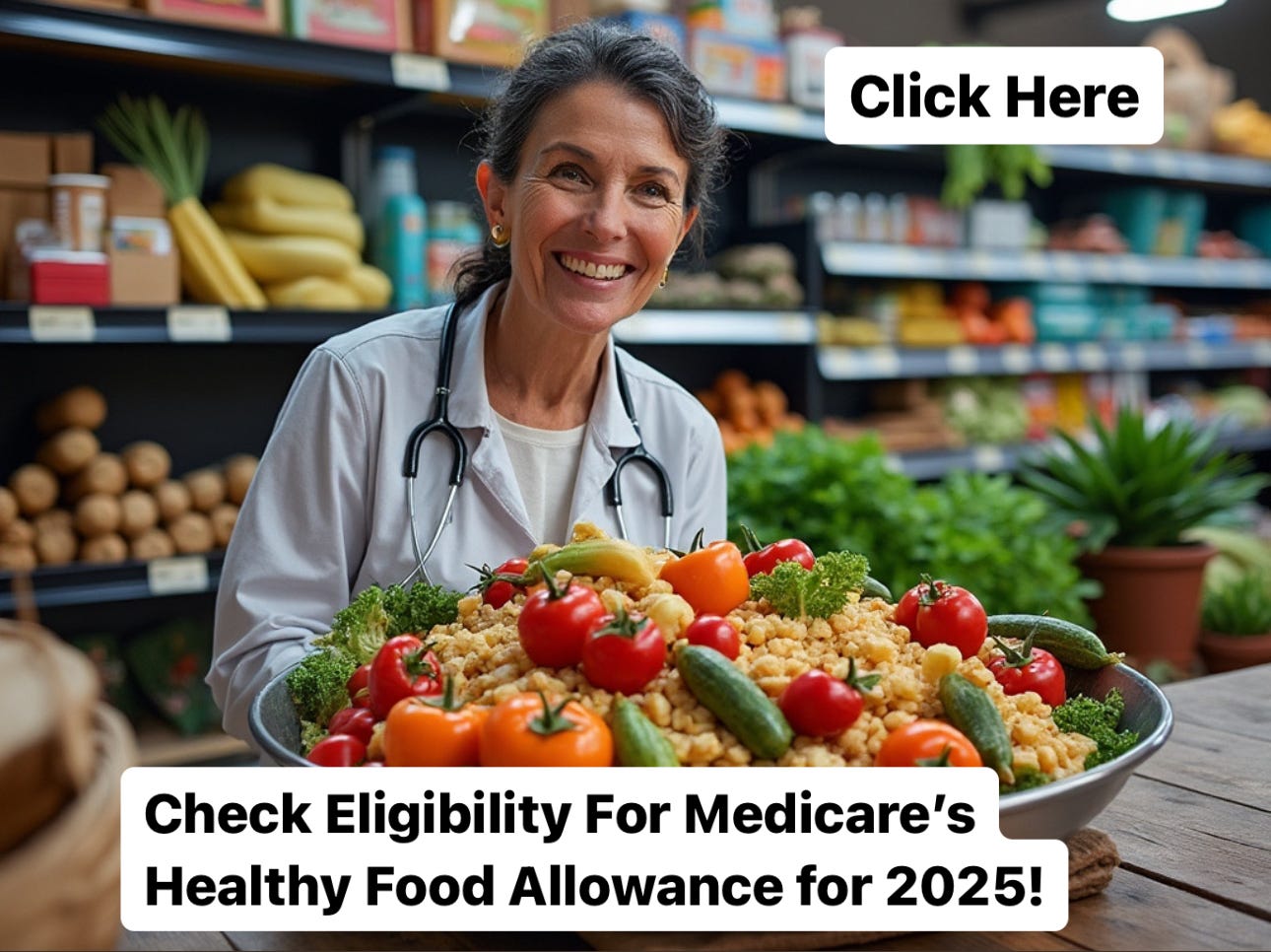Welcome to Medicare Matters, the blogcast where we talk about what matters most for seniors and Medicare beneficiaries. I’m your host, Richard Battell, and today’s episode is crucial for anyone struggling to afford healthy, nutritious meals in America—especially seniors who are often living on a fixed income. We’re going to break down everything you need to know about the Medicare Healthy Food Allowance and Medicare Food Card, two programs that can be lifelines for those in need of better access to healthy food.
But that’s just one part of our discussion. It’s no secret that many of us are having a harder time affording the basics, let alone healthy food options. For millions of Americans, including seniors, rising food prices and limited access to nutritious meals aren’t the only concerns. There’s a deeper issue at play—one that involves large American food brands and their widespread use of harmful ingredients in the foods we consume every day. These ingredients are contributing to long-term health problems, many of which lead us straight into the hands of Big Pharma. We’ll talk about how this cycle works and why it disproportionately affects older Americans, especially those relying on Medicare.
If you’re a senior, a caregiver, or just someone trying to make sense of how to eat healthy on a budget, this episode is for you.
What Is the Medicare Healthy Food Allowance and Food Card?
Let’s start with the basics. The Medicare Healthy Food Allowance is a benefit that some Medicare Advantage plans offer to help beneficiaries afford healthy foods. This allowance typically comes in the form of a Medicare Food Card, which can be used to purchase eligible food items at participating grocery stores, supermarkets, and even some online retailers. Depending on your plan, the card might provide you with a set dollar amount each month—often around $50 to $100—to spend on nutritious groceries.
This allowance is part of a broader push to encourage Medicare beneficiaries to eat healthier, as studies have shown that proper nutrition can significantly improve outcomes for those with chronic health conditions like diabetes, high blood pressure, and heart disease. However, it’s important to note that this benefit isn’t available through Original Medicare—it’s specific to certain Medicare Advantage plans.
Now, you might be thinking, “Why doesn’t Original Medicare cover healthy food? Isn’t nutrition key to preventing illness?” And you’d be absolutely right to ask that question. Unfortunately, Medicare hasn’t yet fully embraced preventive care when it comes to diet, even though we know how critical it is. That’s why these benefits are mostly found within Medicare Advantage plans that are looking to incentivize healthier living.
Let’s look at the numbers. According to research by the National Council on Aging, about 25% of seniors in the U.S. experience food insecurity—meaning they can’t reliably afford enough nutritious food to live a healthy life. Imagine being 70, living on Social Security, and having to choose between paying for your medications or buying groceries. This is the reality for millions of people, and it’s especially difficult for seniors who often have more health concerns and fewer resources.
This is where the Healthy Food Allowance and Food Card can make a difference. With this extra financial support, seniors can stretch their budget a little further, ensuring they can afford more nutritious foods that improve their overall health and well-being.
Why Affording Healthy Food Is So Challenging for Seniors
It’s no secret that affording food in America has become increasingly difficult. Grocery prices have skyrocketed, and healthier options—organic fruits, vegetables, lean proteins—are often the most expensive items in the store. This creates a vicious cycle, particularly for seniors on fixed incomes.
For many seniors, their income consists solely of Social Security benefits. The average Social Security retirement benefit is about $1,800 per month as of 2024. When you factor in rent, utilities, medications, and other living expenses, there’s often very little left for food—let alone healthy food. So what do many seniors do? They buy what they can afford, and unfortunately, that often means cheap, processed foods.
Processed foods are convenient and often less expensive than whole, fresh foods, but they come at a hidden cost. Many of these products are high in sugar, sodium, unhealthy fats, and additives that have been linked to a variety of health problems, from obesity and heart disease to diabetes and even cancer. So, while they may seem like a quick solution to hunger, they can lead to long-term health complications—especially for seniors who may already be dealing with chronic illnesses.
What makes matters worse is that many low-income neighborhoods, particularly in rural areas, are what we call food deserts—areas where access to fresh, nutritious food is severely limited. In these places, the only grocery store might be a convenience store or a gas station that primarily sells processed, packaged foods. This further limits the options for seniors who want to eat healthily but simply can’t access the foods they need.
This is why the Medicare Healthy Food Allowance can be so important. It can help seniors afford and access healthier options, but even that’s just a small part of a much larger issue.
The American Food Industry and Its Role in Health Problems
Now, let’s take a step back and look at the bigger picture. We need to ask ourselves—why is it so hard to afford healthy food in America, and why are so many of the affordable options so unhealthy? The answer lies in the practices of many American food brands.
Let’s face it: a lot of the processed foods that dominate grocery store shelves are packed with harmful ingredients. These include high fructose corn syrup, artificial colors, preservatives, and hydrogenated oils. These substances are not only unhealthy but also addictive, making it harder for people to switch to healthier options once they’re hooked on cheap, processed foods. And who benefits from this? The food industry, which makes billions from selling these products, and, indirectly, the pharmaceutical industry.
Many of these harmful ingredients contribute to chronic conditions like diabetes, obesity, hypertension, and heart disease. Once people develop these conditions, they often require long-term medications—medications that are highly profitable for pharmaceutical companies. It’s almost as if the food and drug industries are working hand-in-hand, creating a cycle where unhealthy food leads to illness, which then requires expensive treatments and medications.
Let’s talk about some specifics. The FDA (Food and Drug Administration) allows many food additives in the U.S. that are banned in other countries. For example, artificial dyes like Red 40 and Yellow 5 are linked to hyperactivity in children and are banned in Europe. Yet, they’re still found in American cereals, snacks, and beverages. Similarly, brominated vegetable oil (BVO), which is used in some sodas, has been linked to memory loss and other cognitive issues. It’s banned in over 100 countries—but not here.
Seniors are especially vulnerable to these harmful ingredients because their bodies are less able to process toxins, and they’re more likely to suffer from chronic diseases that can be worsened by poor diet. Yet, many seniors don’t have the means to avoid these dangerous foods because they’re simply the cheapest and most accessible options.
This toxic food environment creates a direct pipeline from grocery stores to the doctor’s office, and it disproportionately affects low-income seniors who are already struggling to make ends meet.
How the Medicare Healthy Food Allowance Can Help Break the Cycle
The Medicare Healthy Food Allowance is designed to help seniors break free from this cycle of poor diet and poor health. By providing extra financial assistance for nutritious foods, this benefit empowers seniors to make better choices at the grocery store.
With the Medicare Food Card, beneficiaries can purchase healthy staples like fresh fruits, vegetables, whole grains, lean proteins, and low-fat dairy products. These are the kinds of foods that can help manage or even prevent chronic conditions, reducing the need for costly medications down the line.
Let’s break down how you can use the Medicare Food Card to make the most of your food budget:
• Focus on Whole Foods: Whole, unprocessed foods like fruits, vegetables, and whole grains provide the most nutrition for your dollar. They’re packed with the vitamins, minerals, and fiber your body needs to stay healthy.
• Plan Your Meals: Meal planning is key to making the most of the Medicare Healthy Food Allowance. By planning your meals for the week, you can avoid impulse buys and ensure you’re getting a balanced diet.
• Shop Smart: Look for sales and use coupons whenever possible. Many grocery stores offer discounts on healthy items, and you can stretch your food card benefits further by shopping during sales.
It’s also important to be aware of the limitations of the Medicare Food Card. While it covers healthy food items, it generally doesn’t cover non-food items or junk food. This can be a blessing in disguise, as it forces you to focus on nutritious options rather than processed snacks and sugary beverages.
However, while the Medicare Healthy Food Allowance is a valuable resource, it’s still just a Band-Aid solution for a much larger problem. The real issue is the food system itself, which prioritizes profits over people’s health.
What Needs to Change in the American Food System
So, how do we fix this broken system? The Medicare Healthy Food Allowance is a great start, but it’s not enough. To truly improve the health of seniors—and all Americans—we need a complete overhaul of the way we produce, market, and sell food in this country.
First, there needs to be greater regulation of harmful ingredients. If other countries can ban dangerous additives and preservatives, so can we. The FDA needs to prioritize public health over corporate profits by tightening restrictions on what’s allowed in our food supply.
Second, we need to address food deserts and make healthy food more accessible to everyone, regardless of where they live. This means investing in infrastructure that brings grocery stores, farmers’ markets, and fresh food co-ops to underserved areas.
Third, we need more education about nutrition and healthy eating, especially for seniors. Many people simply don’t know how harmful processed foods can be or how to eat healthier on a budget. Medicare could play a role here by offering more resources and support for nutrition education.
Finally, we need to hold both the food industry and pharmaceutical companies accountable for their roles in creating and perpetuating this cycle of illness. It’s time for a food system that puts people’s health first, not profits.
To wrap up, the Medicare Healthy Food Allowance and Food Card are important tools for seniors trying to eat healthily on a fixed income. They provide much-needed financial relief and make it easier to afford nutritious meals. However, these programs are just one part of the solution.
The real change needs to come from how we, as a society, prioritize health and nutrition. Until we fix the broken food system, seniors—and all of us—will continue to face an uphill battle in staying healthy.
Thank you for joining us on this episode of Medicare Matters. Remember, eating well is one of the best things you can do for your health. If you’re eligible for the Medicare Healthy Food Allowance, make sure to take advantage of it. And if you’re interested in learning more about how to stay healthy as a senior, be sure to follow our blog and subscribe to our newsletter.
Until next time, stay healthy and take care of yourself.









Share this post